Hunza Valley is a testament to its unique cultural identity. Characterized by pure, healthy, and distinctive dishes that stand apart from the rest of Pakistan. Hunza Valley has long been celebrated for its pristine environment and bountiful produce. Top 5 Best Traditional Foods Of Hunza Valley? which form the cornerstone of its traditional cuisine. The people of Hunza attribute their robust health and vitality to the nourishing diet they have enjoyed for centuries.
In ancient times, the Hunza diet was revered for its ability to promote longevity and well-being. Drawing upon the abundance of natural resources in the valley. Hunza cuisine embodies simplicity and wholesomeness, reflecting a deep connection to the land and its bounty. Influenced by the cultural exchanges along the historic Silk Road. The culinary traditions of the region bear resemblances to those found in neighboring Central Asian countries. Adding a layer of richness and diversity to its gastronomic tapestry.
For those seeking to explore the authentic flavors of Gilgit-Baltistan. Hunza Valley cuisine offers a tantalizing array of dishes that showcase the region’s culinary prowess. From tender fruits plucked from orchards to hearty grains harvested from terraced fields. Each ingredient embodies the essence of the valley’s fertile landscape.
What sets Hunza Valley cuisine apart from its counterparts in Pakistan is its minimal use of spices. Unlike the bold and fiery flavors commonly associated with Pakistani cuisine. Hunza dishes rely on the natural flavors of the ingredients, allowing their inherent richness to shine through. This subtle approach to seasoning not only accentuates the freshness of the produce but also reflects a philosophy of balance and harmony in culinary practice.
Among the signature dishes of Hunza Valley is the Hunza Chapshuro. This traditional flatbread, made from whole wheat flour and filled with a savory mixture of meat, vegetables, and herbs. Exemplifies the region’s rustic charm and culinary ingenuity. Served piping hot and accompanied by homemade yogurt or tangy chutneys, Hunza Chapshuro embodies the essence of comfort food. Offering a wholesome and satisfying meal for any occasion.
Another staple of Hunza cuisine is the Apricot Kernel Soup, known for its nourishing properties and delicate flavor profile. Served alongside crusty bread or steamed rice. Apricot Kernel Soup provides a comforting respite from the cold, infusing warmth and vitality into the body.
In addition to its savory delights, Hunza Valley cuisine also boasts a delectable array of desserts and sweet treats. From mouthwatering apricot jams to succulent dried fruits. The region’s confectionery offerings are a testament to the abundance of seasonal produce and the artistry of local artisans. One such delicacy is the Hunza Walnut Cake. A dense and moist confection bursting with the flavors of freshly harvested walnuts and honey. Paired with a steaming cup of Hunza Chai, this indulgent treat offers a taste of paradise in every bite.
In essence, the culinary heritage of the Hunza Valley is a celebration of purity, health, and tradition. Rooted in the rich tapestry of the region’s cultural history. Hunza cuisine embodies the spirit of resilience and vitality that has sustained generations of inhabitants amidst the rugged beauty of the Himalayas. Whether savoring a simple meal at home or indulging in a feast fit for royalty. The flavors of Hunza Valley cuisine serve as a reminder of the enduring bond between food, community, and the natural world.
Hoi lo Garma
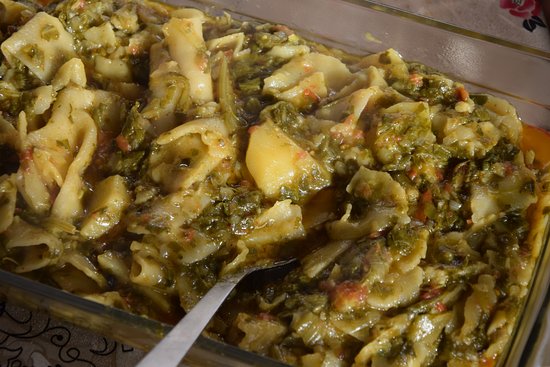
Hoi lo Garma stands as a culinary gem from the heart of the Hunza Valley. Embodying richness and depth in every bite. This cherished dish intertwines the delicate flavors of homemade pasta with the crisp freshness of Romaine lettuce. Creating a symphony of taste that tantalizes the palate and leaves a lasting impression.
To craft this culinary masterpiece, begin by preparing the Romaine lettuce, chopping it finely and boiling it until tender. Drain the lettuce to remove any impurities, ensuring a clean and vibrant base for the dish. In a pan, heat vegetable oil and sauté red onions until they turn a golden brown hue, infusing the dish with a savory depth of flavor.
Next, add the boiled lettuce and potatoes to the pan. Seasoning with salt to enhance the natural sweetness of the ingredients. Allow the mixture to simmer, allowing the flavors to meld and the vegetables to soften to perfection. A splash of water helps to create a luscious sauce that envelops the ingredients. Adding a touch of moisture and richness to the dish.
Meanwhile, prepare the thin-layered flatbread pasta that will serve as the crowning glory of Hoi lo Garma. Using a mixture of water and whole wheat flour, roll out the pasta into thin, round shapes. Ensuring a light and delicate texture. As the water in the pan comes to a gentle boil, introduce the apricot nut paste, infusing the dish with a subtle sweetness and nutty undertones.
Layer by layer, add the pasta to the simmering liquid. Allowing each piece to soften and absorb the flavors of the sauce. With each addition, the dish takes on a new dimension of taste and texture, culminating in a harmonious blend of flavors that dance on the taste buds. To finish, sprinkle freshly chopped green onions over the dish. Imparting a burst of freshness and vibrancy that elevates the flavor profile to new heights.
In essence, Hoi lo Garma is more than just a dish—it is a culinary journey that celebrates the rich heritage and vibrant flavors of the Hunza Valley. With its intricate layers of taste and texture, this beloved recipe captures the essence of traditional Hunza cuisine. Inviting diners to experience the warmth and hospitality of this storied region with each and every bite.
Molida
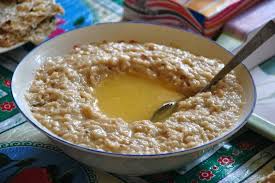
Molida, a culinary delight hailing from the picturesque Gojal valley. Is a beloved dish cherished for its exquisite flavor and cultural significance within the Wakhi community. Renowned for its deliciousness, Molida holds a special place in the hearts and palates of those who partake in Wakhi festivals and celebrations. Where it often takes center stage as a symbol of joy and abundance. Crafted from a harmonious blend of yogurt, flatbread, and apricot oil. Molida is a testament to the ingenuity and resourcefulness of Wakhi cuisine.
To embark on the culinary journey of creating Molida. One must first begin by warming buttermilk in a pot over low heat, infusing it with a subtle richness and creaminess that forms the foundation of the dish. Into this velvety base, chunks of baked flatbread are lovingly added. Their hearty texture providing a satisfying contrast to the smoothness of the buttermilk. With a gentle stir, the ingredients meld together, creating a cohesive mixture that promises to delight the senses with every spoonful. As the Molida simmers gently on the stovetop. Its aroma fills the air, drawing eager anticipation from all who await its completion. This fragrant infusion adds a touch of sweetness and complexity to the Molida. Elevating its flavor profile to new heights and imparting a subtle richness that lingers on the palate.
Traditionally, Molida is enjoyed in the company of others. With locals gathering around communal bowls to partake in this shared culinary experience. As each spoonful is savored and enjoyed, bonds are strengthened, and memories are made. Creating a sense of unity and camaraderie that embodies the spirit of Wakhi culture.
In essence, Molida is more than just a dish—it is a celebration of tradition, community, and the rich tapestry of flavors that define Wakhi cuisine. With its simple yet sublime ingredients and time-honored preparation methods. Molida serves as a delicious reminder of the cultural heritage and culinary heritage of the Gojal valley. Inviting all who partake to savor the taste of tradition and experience the warmth of Wakhi hospitality firsthand.
Giyaalin
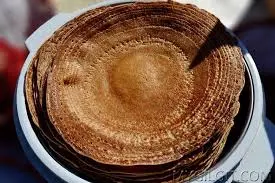
In the culinary landscape of Gilgit-Baltistan, Gyal stands out as a beloved delicacy, revered for its simplicity and irresistible flavor. Found under various names across the region, these crepes or pancakes. known locally as Giyaalin, are a testament to the rich gastronomic heritage of the area. Showcasing the bounty of wholesome ingredients and age-old culinary traditions that define Gilgit-Baltistan cuisine. Crafted from either whole wheat or buckwheat flour, Giyaalin embodies the essence of natural goodness. With each bite offering a hearty blend of earthy flavors and satisfying textures. This harmonious marriage of flavors creates a symphony of taste that tantalizes the senses and leaves a lasting impression on all who partake.
To truly savor the authentic breakfast experience of Gilgit-Baltistan, pair your Giyaalin with a steaming cup of salted tea. This traditional beverage, brewed with a pinch of salt for added depth and complexity. Serves as the perfect accompaniment to the hearty flavors of the pancakes. Creating a balanced and invigorating start to the day.
The act of preparing and sharing Giyaalin embodies the spirit of community and togetherness that defines the culinary culture of the region. Fostering connections and creating cherished memories that last a lifetime.
To recreate this beloved dish at home, simply prepare a liquidy batter reminiscent of pound cake batter by combining flour with water. Next, pour a scoop of the batter onto a pan heated over low to medium heat, spreading it into a thin layer with a ladle. Once the pancake begins to change color to a light brown hue, flip it to cook the other side. Before serving, generously apply walnut oil to the surface to impart a luscious finish that enhances the overall indulgence of the dish.
In essence, Giyaalin is more than just a pancake—it is a culinary journey that celebrates the flavors, traditions, and hospitality of Gilgit-Baltistan. With its wholesome ingredients, rich flavors, and warm hospitality, Giyaalin embodies the essence of Gilgit-Baltistan cuisine. Inviting all who partake to experience the true taste of the region and the warmth of its people.
Ghilmindi
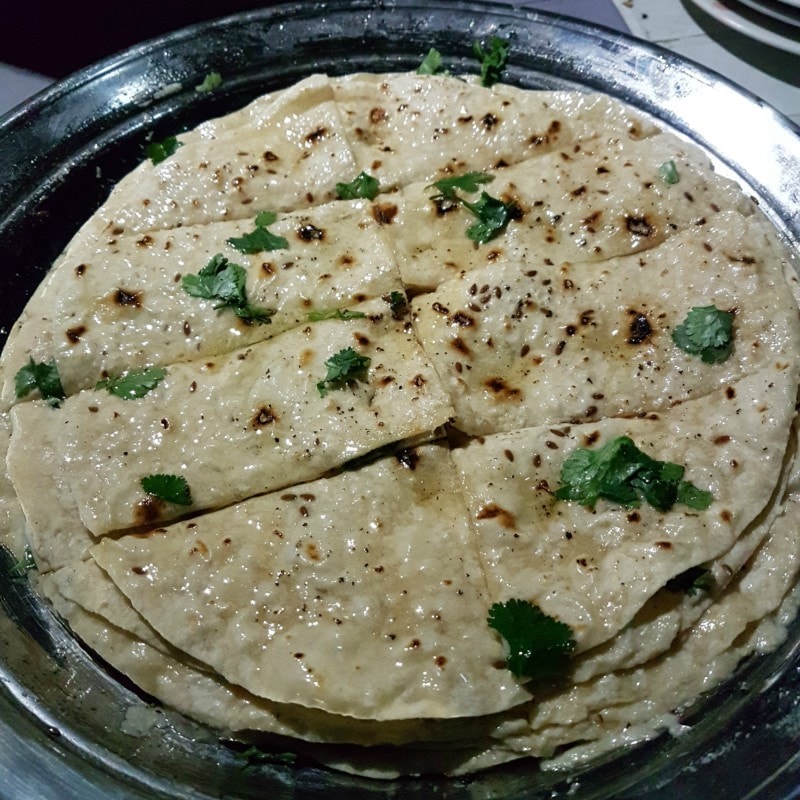
Ghilmindi, a cherished Pamiri delicacy, holds a special place in the culinary traditions of Gojal-Hunza. Celebrated during auspicious occasions like the plowing season. Similar to Booros Tzapick, this traditional dish captivates with its delicious and nourishing combination, offering a taste of Pamiri heritage.
To prepare Ghilmindi, start by layering two pieces of wheat bread, Chapati, or flatbread. In a bowl, mix yogurt with salt and red chili powder, creating a flavorful concoction that adds a tantalizing kick to the dish. Spread this mixture generously over one piece of bread and sandwich it with the other, forming a delectable union of flavors.
Before serving, lavish the Ghilmindi with a generous drizzle of apricot oil. Infusing the dish with a subtle sweetness and enhancing its overall richness. The result is a symphony of salty-sour tastes that awaken the palate and leave a lasting impression, beckoning for seconds and thirds.
Ghilmindi epitomizes the essence of Pamiri cuisine. Blending simple yet vibrant ingredients to create a dish that delights both the senses and the soul. Whether enjoyed during festive gatherings or everyday meals. Ghilmindi is a true testament to the culinary ingenuity and cultural richness of Gojal-Hunza, inviting all who partake to savor the flavors of Pamiri tradition.
Chamus
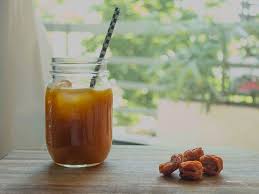
Hunza Valley, drinks hold a special place, offering not only refreshment but also a glimpse into the region’s rich cultural heritage and natural abundance. Among these cherished beverages, Chamus stands out as a quintessential summer drink. Elebrated for its refreshing taste and nourishing properties that invigorate the senses and rejuvenate the body.
Derived from dried apricots, Chamus embodies the essence of simplicity and wholesomeness. Drawing upon the bounty of the land to create a beverage that is both delicious and nutritious. As a staple of Hunza cuisine, Chamus serves as a testament to the ingenuity and resourcefulness of the Hunza people. Who have long relied on the natural goodness of their surroundings to sustain themselves and their communities.
To embark on the culinary journey of making Chamus, one must first begin by selecting high-quality dried apricots, which serve as the primary ingredient of this beloved drink. This hands-on approach not only helps to extract the maximum flavor from the apricots but also infuses the Chamus with the essence of human touch. Adding an element of warmth and connection to the beverage.
As the apricots continue to mingle with the water, their flavors intensify. Creating a vibrant concoction that tantalizes the taste buds and refreshes the palate. Once the desired consistency is achieved, the Chamus is ready to be served. Either chilled or at room temperature, depending on personal preference. The drink’s tangy sweetness and subtle acidity offer a delightful contrast to the summer heat. Providing a moment of respite and rejuvenation in the midst of nature’s bounty. Rich in antioxidants and nutrients, dried apricots lend their nutritional prowess to the beverage. Offering a boost of energy and vitality with every sip.
In essence, Chamus is more than just a drink—it is a celebration of the natural abundance and cultural heritage of the Hunza Valley. With its simple yet flavorful ingredients and nourishing properties. Chamus embodies the spirit of Hunza cuisine. Inviting all who partake to experience the taste of tradition and the warmth of hospitality that define this storied region.
Conclusion
The culinary heritage of the Hunza Valley is a testament to its unique cultural identity, characterized by pure, healthy, and distinctive dishes that stand apart from the rest of Pakistan. Top 5 Best Traditional Foods Of Hunza Valley? Renowned for its longevity, the people of Hunza attribute their robust health and vitality to the nourishing diet they have enjoyed for centuries.
Drawing upon the abundance of natural resources in the valley, Hunza cuisine embodies simplicity and wholesomeness, reflecting a deep connection to the land and its bounty. Influenced by the cultural exchanges along the historic Silk Road, the culinary traditions of the region bear resemblances to those found in neighboring Central Asian countries, adding a layer of richness and diversity to its gastronomic tapestry.
For those seeking to explore the authentic flavors of Gilgit-Baltistan, Hunza Valley cuisine offers a tantalizing array of dishes that showcase the region’s culinary prowess. From tender fruits plucked from orchards to hearty grains harvested from terraced fields, each ingredient embodies the essence of the valley’s fertile landscape.
What sets Hunza Valley cuisine apart from its counterparts in Pakistan is its minimal use of spices. Unlike the bold and fiery flavors commonly associated with Pakistani cuisine, Hunza dishes rely on the natural flavors of the ingredients, allowing their inherent richness to shine through. This subtle approach to seasoning not only accentuates the freshness of the produce but also reflects a philosophy of balance and harmony in culinary practice.
Among the signature dishes of Hunza Valley are Hunza Chapshuro, Apricot Kernel Soup, and the Hunza Walnut Cake. Each dish showcases the region’s rustic charm and culinary ingenuity, offering a delightful blend of flavors and textures that captivate the palate. Whether enjoyed during festive gatherings or everyday meals, Hunza cuisine is a true testament to the culinary heritage and cultural richness of the region, inviting all who partake to experience the warmth and hospitality of this storied land.
FAQs:
What are the key characteristics of Hunza Valley cuisine?
Hunza Valley cuisine is characterized by its emphasis on pure, healthy, and locally sourced ingredients. Minimal use of spices allows the natural flavors of the ingredients to shine through, creating dishes that are wholesome and flavorful.
What are some traditional dishes of Hunza Valley?
Some traditional dishes of Hunza Valley include Hunza Chapshuro, Apricot Kernel Soup, and Hunza Walnut Cake. These dishes reflect the region’s rich culinary heritage and are celebrated for their delicious flavors and nourishing properties.
How does Hunza cuisine differ from other Pakistani cuisines?
Unlike other Pakistani cuisines, Hunza cuisine places a greater emphasis on simplicity and wholesomeness. The use of organic and locally sourced ingredients, as well as minimal use of spices, sets it apart from the bold and fiery flavors commonly associated with Pakistani cuisine.
What role does Hunza cuisine play in the local culture and community?
Hunza cuisine plays a central role in local culture and community life, serving as a symbol of hospitality and shared identity. Traditional dishes are often prepared and shared during festive gatherings and special occasions, fostering a sense of unity and connection among community members.
How can one experience Hunza cuisine outside of the region?
While visiting the Hunza Valley offers the most authentic experience of its cuisine, many traditional dishes can be recreated at home using readily available ingredients. Recipes can be found online or in cookbooks specializing in Pakistani and regional cuisines, allowing food enthusiasts to enjoy the flavors of Hunza in their own kitchens.




